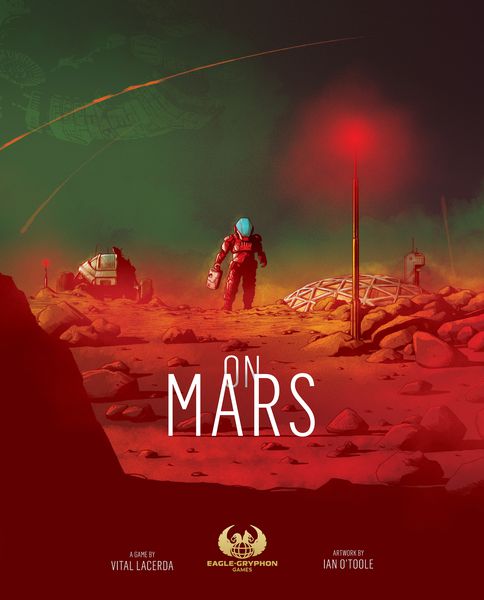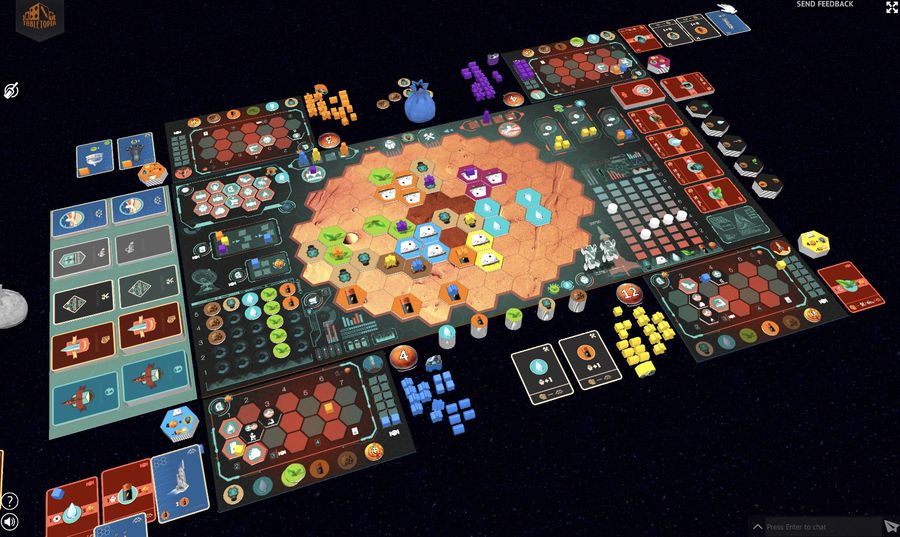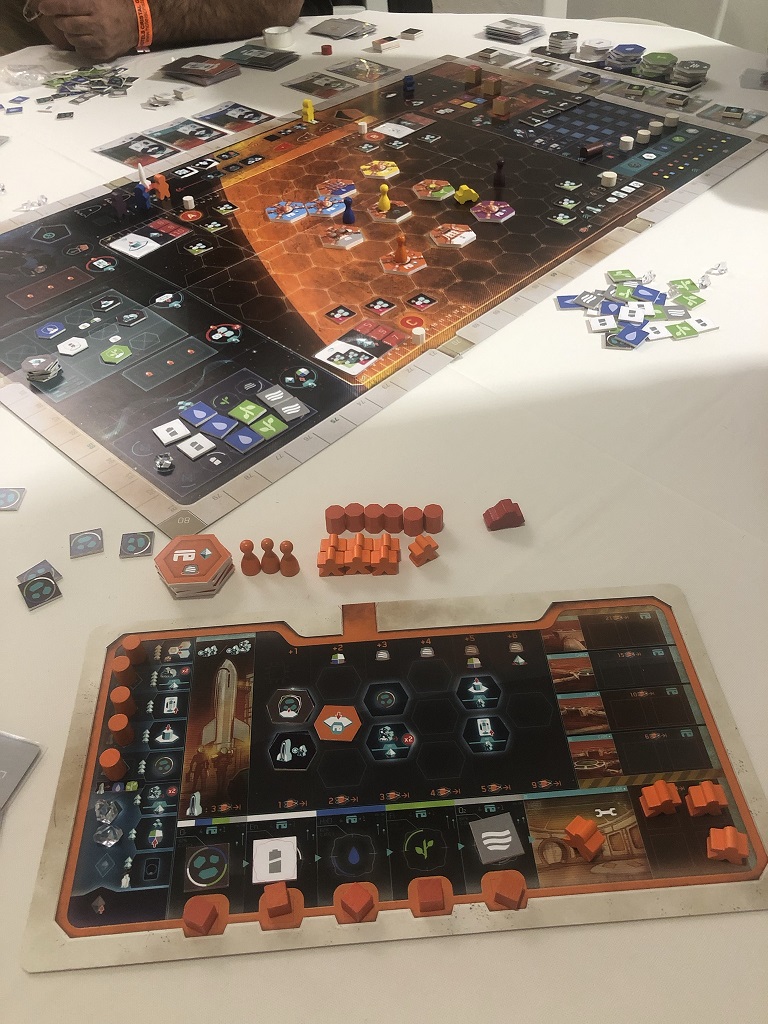On Mars
William Aukes has been playtesting the new title by the renowned Vital Lacerda, for 5 months. Is it any good? Is it your next buy? Well, read on and find out!

Posted 27 April 2019 by William Aukes
- Designer(s): Vital Lacerda
- Publisher: Eagle-Gryphon Games
- Playercount: 1-4
- Length: 90-180min
- Age: 14+
INTRO
Forgive me as we skip the pleasantries. We both know you are here to learn about On Mars, not about the author of this review. Here’s the skinny; I am William Aukes, an avid board gamer and first-time reviewer from northeast Iowa. Over the last 5 months, I have had the privilege of being one of the playtesters for On Mars, and I want to share my experiences with the game in hopes that it may offer some insight into whether or not you make the choice to boldly go in on Vital Lacerda’s next masterpiece.
OVERVIEW
On Mars, simply put, is an action selection game. It is played over several rounds, each consisting of two phases; the colonization phase and shuttle phase. During colonization phases, players will select actions depending on which side of the board they are on, either in orbit or the colony. The shuttle phase allows players to travel via public or private ship, between the colony and orbit, opening up new actions to select in subsequent colonization phases. The public shuttle moves (alternating in direction) on a dedicated schedule based on the advancement of the colony’s Life Support System (LSS) (which I will briefly highlight later). Players are competing to be the most renowned contributors to the development of the new colony on Mars. By construct buildings, hiring scientists, researching technology, completing contracts, and scouring the surface for anything that may be useful in their endeavors, players work to score the most Opportunity Points (OP), signifying their efforts in developing and sustaining this new Martian colony. The game ends after players complete a predetermined number of public objective cards (based on variant and player count). The player with the most OP is declared the winner.

GAMEPLAY/MECHANICS
Below is not a comprehensive review of all of the components and possible actions in the game. Rather, it is meant to highlight some key aspects of the game and simple turn structure.
Colonization Phase
During the colonization phase, players take turns selecting an action on their respective side of the board (orbit or colony). Some actions require colonists to be placed on public action spots, while others are able to be taken without the use of colonists. Action spaces become more expensive as other players occupy them. In addition to their main actions, players also have the ability to take a single executive action. Executive action abilities are unlocked on the left side of your personal player board. Once they are unlocked, players can spend a specific number of crystals to take that action. Crystals can be harvested from the surface of the planet (using your rover), taken from storage (as a main action), and earned by completing actions on the public mission cards. Another source of executive actions is advanced buildings. Players, while in orbit, can take ownership of advanced building blueprints as their main action. Once constructed in the colony, these buildings offer additional executive action options for players at the cost of 2 crystals. While on the colony side, players can hire scientists to work for them. There are 6 scientists available in the game, each one specializing in a specific discipline corresponding to a building type. Once hired, scientists can be used on matching constructed advanced buildings (your own or another players) to make those executive actions free (rather than spending those precious crystals).
Shuttle Phase
Once all players have taken their respective turns, the colonization phase is over and the shuttle phase begins. During the shuttle phase, the public shuttle will move one space toward the opposite side of the board it is on. If the shuttle moves from one side of the board to the other, players may choose to travel with it to the opposite side of the board. At the beginning of the game, the public shuttle moves between colony and orbit every other turn. As the Life Support System increases, the public shuttle travels between orbit less frequently, so players must be precise with the timing of when to travel with the public shuttle and when to use their private ships to travel. After the shuttle phase, players move back into the colonization phase, selecting actions on their respective side of the board.
Life Support System
The Life Support System (LSS) is the public indicator for how the colony is developing throughout the game as well as the needs for the colony to advance to the next level. The LSS is, essentially, four columns representing the construction of necessary buildings corresponding to specific resources (Energy, Water, Plants, and Oxygen). Once each respective column meets the next threshold, the LSS level increases, thus changing the state of the game. The LSS level dictates how frequently the public shuttle travels as well as how many public mission cards must be completed to trigger the end of the game. As the LSS increases, the colony becomes more self-sufficient and less reliant on supplies from orbit. When players construct building tiles of a specific resource, they increase the marker corresponding to that resource on the LSS and gain a reward for doing so. The reward for each column is variable and will be randomly drawn at the start of the game.
Player Boards
The player board acts as a control center for your operations in the game. On your player board is a hexagonal grid that represents your personal technology advancement. One of the orbit side main actions is researching and developing technology. With this action, players select technology tiles to place on their personal board. Technology tiles increase a player’s ability to take certain actions depending on the tile and level it is at. While in orbit, players may choose to upgrade their technology. By paying a cost, players advance their technology and increase its abilities. Your player board also contains a storage area for resources. Each player starts out with the ability to hold a maximum of two of each type of resource. As you expand your personal habitat on the surface of Mars, you unlock the ability to store more goods and house more colonists. Player boards also house your fleet of ships. Ships allow you to travel independently of the public shuttle (during the shuttle phases) and increase your population when you choose the action that allows you to add another one to your fleet. Ships begin on your board covering the executive actions I mentioned earlier. Welcoming a new ship allows players to choose a ship depending on which executive action they would like to add to their arsenal. Players also control a rover and robots throughout the game. One of the main actions of the colony side is moving your rover and robots. Rovers are used to explore the surface for useful materials. Robots are the builders for your operation. New buildings must be built in spaces adjacent to one of your robots, so be mindful of how you maneuver them to set yourself up for success.

THEME
Generally speaking, the “Mars” theme is that dead horse designers keep whacking, unapologetically. On Mars, however, injected life back into a theme I was ready to bury out back next to a headstone that reads “Here lies trading in the Mediterranean”. John Noble Wilford put it nicely when he wrote “Mars tugs at the human imagination like no other planet. With a force mightier than gravity, it attracts the eye to the shimmering red presence in the clear night sky...”. I believe it’s the hope and possibility that we are just an arms reach from ideas once held as science fiction. All of us are glossy-eyed children with big dreams. If you are familiar with Vital’s games, then you likely know that his design process predicates itself on theme. Mechanics are then sculpted to represent the thematic interpretation the game sets out to achieve. On Mars is no exception to this process. The feedback loop of resources represents the essence of homeostasis necessary for a colony to thrive on this strange planet. Colonists are needed to mine ore from the planet. Ore is used to creating energy. Energy is harnessed to melt ice caps to collect water. Water is used to cultivate plants. Plants will produce oxygen. Oxygen will sustain human life and an expanding population. The circle is complete and continuous and is the core driver of the different subsystems in the game. Players must account for the interconnectedness of these resources as they make choices throughout the game. The colony players are constructing on Mars is heavily reliant on supplies from the International Space Station orbiting the Red Planet at the beginning of the game. As the game progresses and the colony becomes more self-sustaining, players make fewer trips to orbit and instead rely on the materials and knowledge they have in the colony. On Mars is fresh. It is unique. And ultimately, a pragmatic interpretation of what the development of the first colony on Mars might look like.
Game Length (1.5-3 hours)
On Mars will take approximately 1.5-3 hours to play, depending on player count. In my online testing, full 4 player games were reliably within the 2-3 hour range so I would anticipate that time being reduced approximately 10 minutes per player for an in-person game (due to the fiddliness of Tabletopia). We had a 4 player game finish right at 2 hours, so I could envision experienced players being able to finish a live game in under 2 hours. Despite its length, On Mars is not plodding experience. The longer games I participated in never felt as such. Players are constantly engaged, outside of their turn. However, if the game length does sound daunting, On Mars offers a “First Colonist” variant that allows players to play through the game in an abbreviated version, which is still true to the full game’s natural arc.
Weight (Medium Heavy)
On Mars is thick, but don’t let the 4.5+ complexity ranking scare you. Learning the rules of the game is not a tremendously difficult task. It is understanding the interconnectivity of the games’ subsystems that requires work from players. It took me a full playthrough before I was comfortable with my understanding of the game. After that, the nuances of the mechanics began to blossom and the game really opens up to players. I would hesitate to suggest On Mars for the casual gamer. If this is your first jump into Vital’s work, I would consider starting with Vinhos Deluxe Edition. That being said, if you are willing to make the upfront investment in learning this game, it is one that will reward your time and effort exponentially.
Player Count
1p- Good*
2p- Good*
3p- Great
4p- Great
On Mars shines at higher player counts. My favorite playthroughs were 3-4 player games, where players are constantly appraising each other’s tableaus, weighing the consequences of borrowing each other’s technology or advanced buildings. Player interaction is what makes this game great. I would not say On Mars is optimized for 2 players. Nonetheless, I have played great games with the 2 player rules and plan to play mostly at this count, with my wife, when I have my hands on the final product. The basic solo game presents an interesting challenge, where players attempt to complete mission cards of varying difficulty. The solo game is crunchy and brain-burning (and only getting better as it is being developed).
*Note: The solo and 2 player rules were still in development during the time of this review and are subject to change my final opinion. More advanced solo rules are being developed to recreate the player interaction present in the multiplayer games*
Replayability
Like the universe we reside in, replayability is without bounds. I cannot fathom how one could ever become bored of this game. Each new game will offer a unique board state with variability in the initial building locations of the colony, public and private mission cards, rewards for improving the Life Support System (LSS), and available starting advanced buildings. The combinations players will discovery through the use of scientists, advanced buildings, and their technology leaves this new world open for players to explore.
Final Thoughts
On Mars is an artful matrimony of tactics and strategy. The game is tight but forgiving. Resources are scarce. Territory hexes fill up fast. Technology tiles are finite. Advanced buildings each have their own unique specialty. Each building type in the game has exactly one scientist that specializes in that discipline so snagging the right one to work in your advanced buildings can be game-changing. Time is one of the most important resources to manage in the game. Calculating when to travel between orbit and the colony is vital. So many consequences to consider when executing your plans. Like any astronaut who is worth their salt, players must be able to analyze the situation as it evolves before them and adapts to the ever-changing state of the game if they want to survive and come out on top.
The Kickstarter is over by now, and the game will be hitting the stores soon.
On Mars is bold. On Mars is ambitious. On Mars is extraordinary.
Review by guest-star William Aukes (Beer4Dad @ BGG), cheers!
Return to Reviews



